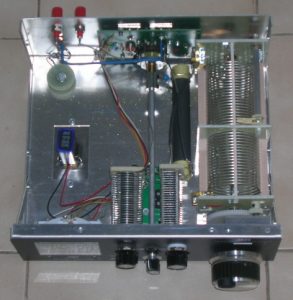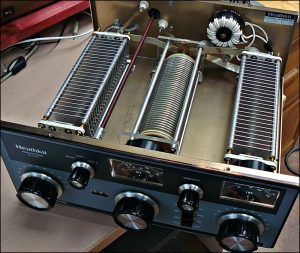
Sunday, Sept. 30, 2018 — I’m being a bit of a pain this afternoon, and ragging on MFJ’s AirCore roller inductor technology. Honestly, I don’t have a personal bad experience with MFJ’s AirCore rollers — I have an MFJ-969 in place in Studio B, a 300-watt tuner equipped with the AirCore roller, and I have had no problems with it. But as is usually the case, much of MFJ products are widely maligned with the “Mighty Fine Junk” moniker.

I really can’t complain with my experiences with MFJ, either. My first MFJ product was a second-hand converter that let your 2-meter HT tune public service frequencies. I only used it a short time before I sold it for a small profit. My next MFJ product was a new purchase — an MFJ-941D antenna tuner, brand new from R&L Electronics in southern Ohio.
My first HF antenna was a longwire, which worked well but radiated the entire upstairs of the house we were in with RF. I replaced the longwire with a doublet fed with twinlead, and used it all the HF bands, 80 thru 10.
And that’s the main type of antenna I’ve used on HF for nearly 30 years — various wire doublets, usually non-resonant. The MFJ-941D did well matching the antenna at every QTH I’ve lived. I eventually sold it at a hamfest and purchased a Heathkit SA-2040. I later purchased its big brother, the SA-2060; however this SA-2060 had the metering circuitry and coax switch removed. Electrically, it was the same as the SA-2040, it had the front panel and meters of the nicer SA-2060. I’ve used it in the shack for well over 20 years.
The MFJ-941D was a great Field Day tuner; I regretted selling it. I eventually began buying similar MFJ tuners that were broken or had issues and working on them. I kept them handy for the club’s field day efforts.

STUDIO B TUNER. I used one of the tapped coil tuners here at my second shack in the library of our home, but I missed having a roller inductor tuner. I ran across a very inexpensive MFJ-969, which is a 300-watt roller tuner and I’ve been using that ever since. I have the same type of balanced line-fed doublet and its done a great job. The antenna is still down, but I’m going to try to shoot a support line over the tree outside the house tomorrow; I really miss having a rig here in the library.
TUNER TUNE-UPS. I’m a sucker for second-hand antenna tuners — almost as much as I am for morse code keys. The difference is I don’t watch many antenna tuners on eBay unless I think about it.
My current project is fixing up an MFJ-989B tuner, MFJ’s “high power” tuner rated at “3kw.” The tuner was a low-buck find on eBay, mostly because it had some issues visible. The meter was loose and laying inside the cabinet for starters. I picked it up for a song, but wasn’t sure what the components inside looked like.

When it arrived, the components looked like brand new — no arcing visible or other damage. This is one of the older iterations of the 989 tuner, so it is equipped with a “real” roller inductor (one with an actual core). I already have the next version of the tuner — the MFJ-989C — in the shack at the moment, and the only difference between the “B” and “C” models was the addition of the peak-reading output meter function.
The B and C models both feature “real” roller inductors, i.e., ones with real cores and are not the “AirCore” rollers used on later tuners.
The “3kw” moniker is misleading in a way because it makes one believe the circuit and components are bulletproof (i.e., like Heathkit tuners). The tuner handles “legal limit,” but there’s an asterisk there — the tuner needs to be properly adjusted, otherwise, you’ll probably have some arcing inside the tuner. The manuals have such warnings.
The first “3kw” MFJ-989C I purchased was cheap because the roller inductor wouldn’t turn. I decided to gamble on it and purchased it. On arrival, I realized this tuner was one of the many MFJ tuners to suffer at the hands of a serious, high-power mismatch. The nylon core of the roller inductor apparently got hot enough to melt (!), and some of the plastic slumped in a blob that blocked the roller from rolling. Other than the melted nylon, (and the end of the coil loose from the core), the parts were in good shape. I cut the blob of plastic off the core, and the tuner is working great. I removed the SA-2060 in the main shack and have been running the MFJ-989C ever since.
PARTS STILL AVAILABLE. The early MFJ roller inductor tuners used a rubber “O” ring to connect the shaft of the roller inductor to the turns counter. The O ring on the “B” model I have is broken, but according to MFJ, they are still available. Tomorrow I’ll order several to keep them on hand.
Once the belt is replaced, the tuner will be in perfect shape. I’ll check it out, and decide if I want to keep it or send it back to eBay. I’ve sold all of my tapped coil MFJ tuners. It must be a ham thing to want to keep “spare” equipment in storage. I like to have spare tuners if needed for an impromptu station somewhere. I still have the first rigs I bought for my library “Studio B” shack … the IC-746, the IC-756PRO and IC-756PROII. I need to part with all three, maybe I can purchase an ICOM IC-7300 or 7600.
73 es CUL de KY4Z … SK SK …. dit dit …
